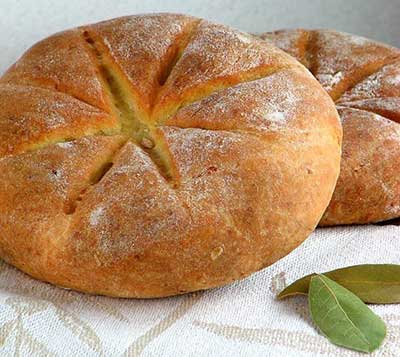Recipe for Libum
(sweet cheesecake)

by Cato, De Agricultura
Libum was a sacrificial cake sometimes offered to household spirits during Rome's early history. The recipe below comes from the Roman consul Cato's agricultural writings, which included simple recipes for farmers. Libum, sometimes served hot, is a cheesecake he included. Cato's recipes for libum and placenta are particularly important historical sources, since both of these cakes were recommended for use in religious rituals.
Original recipe: 'Libum hoc modo facito. Casei P. II bene disterat in mortario. Ubi bene distriverit, farinae siligineae libram aut, si voles tenerius esse, selibram similaginis eodem indito permiscetoque cum caseo bene. Ovum unum addito et una permisceto bene. Inde panem facito, folia subdito, in foco caldo sub testu coquito leniter.'
Translation: 'Make libum by this method. Break up two pounds of cheese well in a mortar. When they will have been well broken up, put in a pound of wheat flour or, if you wish it to be more delicate, half a pound of fine flour and mix it well together with the cheese. Add one egg and mix together well. Then make into bread, places leaves beneath, and cook slowly on a hot hearth under an earthen pot.'
Ingredients
- 1 c. ricotta cheese
- 1 cup of plain flour
- 1 Egg beaten
- 15 bay leaves
- ½ c. clear honey
Preparation
- Sift the flour in a mixing bowl.
- Beat the cheese until soft, stir into the flour.
- Add the beaten egg to the flour/cheese mixture, forming a soft dough
- Divide the dough into four and shape each piece into a bun
- Place on a greased baking tray with bay leaves underneath.
- Heat the oven to 375F - 190C. Bake for 35 - 40 minutes until golden brown.
- Warm the honey, pour into a flat plate, remove the bay leaves, and place the buns in the honey and rest till the honey is absorbed.
- Makes 4 servings.




















